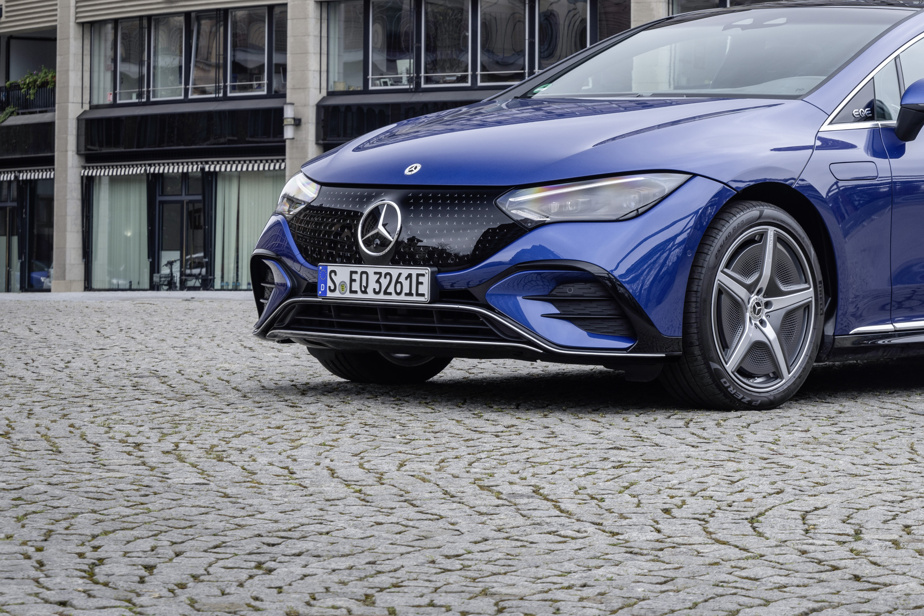It is however necessary to concentrate well to detect the differences of aesthetic approach between the EQE and the EQS. The EQE stops the tape measure at 5m in length, almost 30cm before the large EQS saloon. The EQE thus has a more collected and possibly more coherent look on the profile with its shortened overhangs. Its physiognomy remains ovoid to make it pierce the air and its passenger compartment is pulled forward to increase the interior capacity. Like many electric vehicles, its handles retract so as not to disturb the flow of air. Its front part also reflects this desire to reduce resistance with a sealed grille mimicking, by means of its lacquered black, the face of a vehicle with a combustion engine.
After a slight unlocking delay despite the deployment of the handles, we discover a cabin that rigorously applies the new stylistic language of Mercedes-Benz. Guided by a desire to amaze us, the dashboard is full of diodes whose intensity and coloring can be adjusted. Some modes even feature bright choreography that could be worthy of a Moment Factory piece. That said, beware of distraction. Moreover, the copy tested had – fortunately – not the option of the “Hyperscreen” checked, preferring a large vertical OLED screen of 12.8 inches. This allows a more beautiful expression of the materials used to shape the organic forms that weave the outposts of the cabin. Up front, legroom and headroom are excellent, an observation that doesn’t entirely apply to the rear. There, it is rather the head that suffers because of the arched feature of the roof.
Excluding the AMG variant of this EQE, which runs parallel to the standard lineup, the sedan is available in two ways with standard all-wheel drive. The 350 version has just 288 hp to move around, while the 500 tested increases the count of the two electric motors to 402 hp. With nearly 2.5 tons to move, this mechanism, which is even more discreet than many electric mills from generalist brands, does the job with consistency and firmness. The initial acceleration provided by its 633 lb-ft presses us against the backrest to gradually thin out as the speed increases. The 0-100 km/h in 4.7 seconds reflects its efficiency, but Tesla and Lucid can rest easy by comparison. A 90.6 kWh battery provides storage and can be recharged up to an output of 170 kW, a figure down on the Porsche Taycan and Audi e-tron GT.
We immediately notice that this EQE wants to convey an impression of lightness, even relaxation, in its manners. The steering, without being over-assisted, is devoid of any firmness and appears isolated from vibrations induced by the roadway. It still allows us to place the car with precision in addition to being supported by directional rear wheels that intervene with skill. Not equipped with pneumatic damping adjustable by the driver, the livery tested offered a good level of comfort without, however, guarding against relatively pronounced body movements. The all-wheel drive supports the overall performance with predictability. Even if we try to rush the chassis, it extracts us from the turn with a very neutral and more agile behavior than that of the EQS. Like the latter, braking suffers from too long a pedal stroke. The regenerative system also pushes it in automatically, which can confuse the driver.
This EQE obviously receives the contribution of the latest generation of the Mercedes-Benz infotainment system called MBUX. In its standard version, it is spread over a large 12.8-inch vertical touch screen as well as a second instrumentation screen placed above the steering column. It controls virtually all essential functions with mixed speed at times. The home menu also makes interactions rather complex due to a rather sparse layout of certain tabs. It is also necessary to do too many manipulations for adjustments that are a priori very simple in other vehicles. Finally, the absence of physical keys increases inattention, because our fingers cannot rely on texture changes to orient themselves. That said, the definition of the screens is extraordinary and the functionalities are numerous. The Burmester audio system offers a very acceptable rendering, without however managing to reach the brilliance of the competition offered by Bowers
With the acceleration of the development of electric vehicles, the obsolescence of many models awaits buyers, especially among luxury brands. With highly technology-oriented products, this phenomenon will sooner or later manifest itself acutely. The Mercedes-Benz EQE will probably not escape this observation, but for the moment offers a nice balance between refinement and energy efficiency. In the test, the vehicle consistently exceeded Mercedes-Benz’s estimated 418 km by more than 100 km, according to its algorithms. Its consumption was sometimes around 16 kWh/100 km. It’s excellent, in addition to coating everything with soundproofing worthy of the most opulent large sedans. At $95,000 as the base price for this EQE 500 livery, that’s the least you can say. That said, its formula convinces more than the much more expensive EQS. It’s not nothing, though.
Like the EQS, the EQE is entitled to its SUV counterpart, which has the same version structure and the same engines, in exchange for a fairly inflated bill.
With the addition of rear-wheel steering, this EQE has a turning radius of 10.7m, which is comparable to a Mazda3.
The rear visibility of the EQE is greatly obstructed by the thick pillars and the small glass opening, which forces us to constantly lean on the rear view camera.
With a volume of 430 L, the rear trunk seems ample on paper, but its high and small opening limits its practicality.
Detail that may annoy some: the width of the center console scrounges up legroom. In return, it incorporates a lot of storage.
